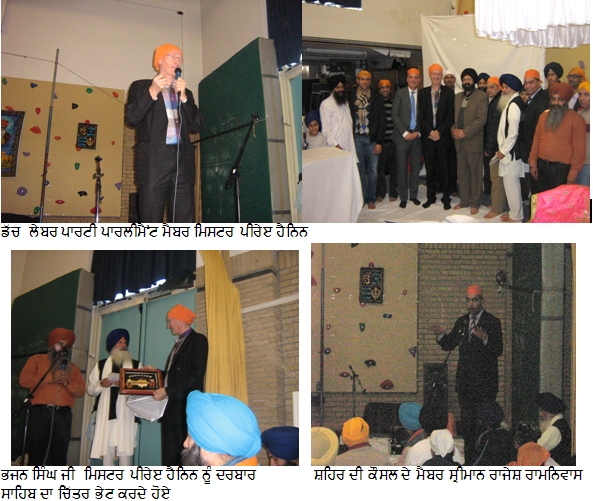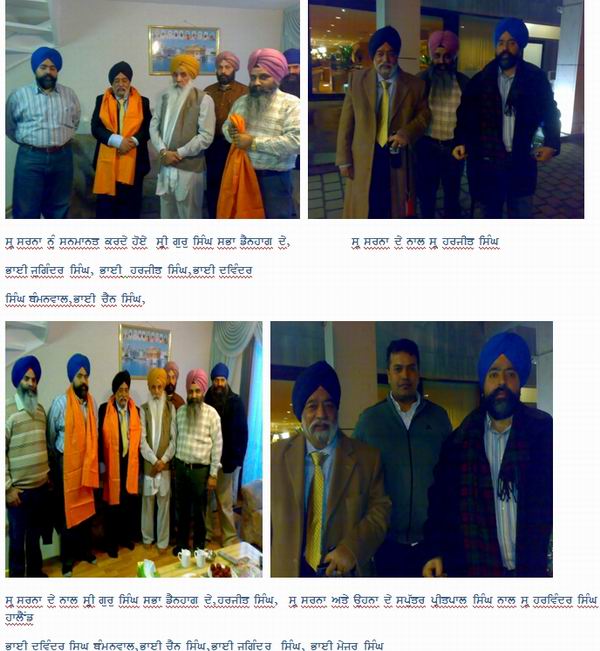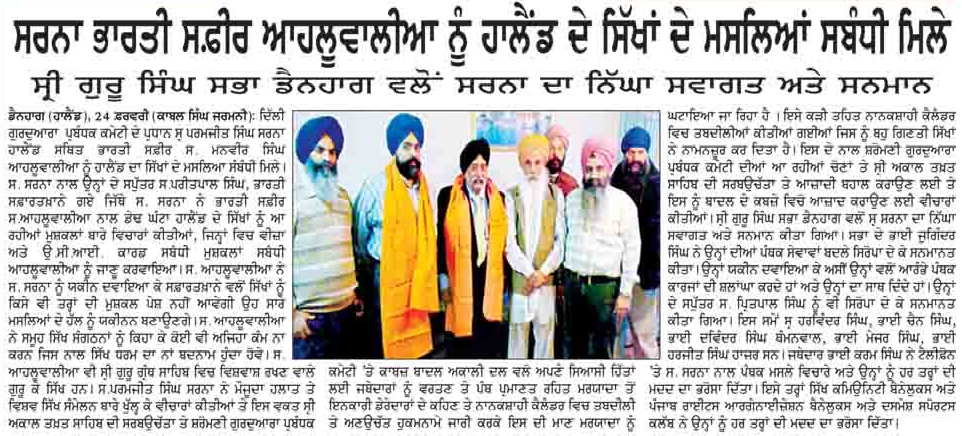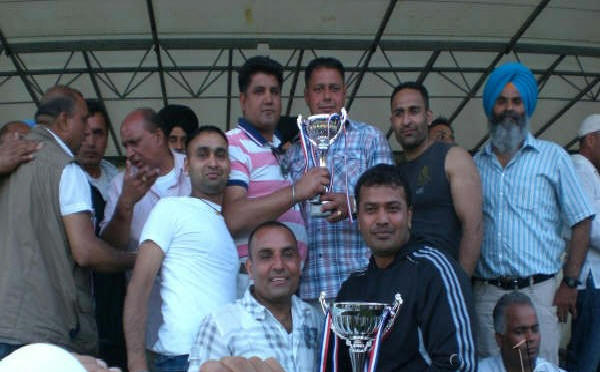|
Mediapounjab, 13-1-2011
SRI gurU isMG sBw fYnhwg hwlYNf ivKy swihb SRI gurU goibMd isMG jI dw
Avqwr idvs SrDw pUrvk mnwieAw fYnhwg c nvY bxn vwly
gurduAwrw swihb bwry sMgqw nMU projYktr lw kw jwxkwrI id`qI ,
pwrlImYNtmYbr phMUcy: hrjIq isMG hwlYNf
.jpg)
f`c lybr pwrtI pwrlImYNt mYbr imstr pIrye hYinn
.jpg)
.jpg)
Bjn isMG jI imstr pIrye hYinn nMU drbwr Sihr dI kOsl dy mYbr sRImwn rwjyS rwminvws
swihb dw ic`qr Byt krdy hoey
.jpg)
.jpg)
fYnhwg09/01/2010: SRI gurU isMG sBw fYnhwg hwlYNf ivKy SRI gurU goibMd isMG jI dw Avqwr idvs 09jnvrI nMU SrDw pUrvk mnwieAw[ sMgqw ny 5 pwvn SRI suKmnI swihb jI dy pwT GrW iv`c kIqy[sMgqW iv`c bhUq hI auqSwh sI[ SRI suKmnI swihb jI dy pwT nwl pRogrwm dI AwrMBqw kIqI geI[ auprMq BweI cYn isMG jI, BweI divMdr iSMG jI rOtrfm vwilAw ny kIrqn nwl sMgqw nMu inhwl kIqw BweI Bjn isMG jI ny guru swihb jI dy Avqwr idvs vwry sMgqw nMu kQw nwl inhwl kIqw[auhnW ny sMHumh sMgqw nMU sRI gurU gRMQ swihb jI dy nwl juVn leI pRYrq kIqw[ BeI Bjn isMG jI ny f`c BwSW iv`c bhUq hI pRBwvSwlI jwxkwrI prlImYNtmYbrW nMu id`qI[
ies smy f`c lybr pwrtI pwrlImYNt mYbr imstr pIrye hYinn phMUcy hoey sn sMmUh sMgqw nMU nvY gurduAwrw swihb dI iqAwrI leI sMgqw nMu sihjog dyx leI ApIl kIqI[ Aqy vrlf hwkI k`p 2014 jo fYnhwg Sihr ivKy ho irhw ausqo pihlw gurduAwr swihb iqAwr krn leI ikhw[ ies smy auhnW nMU BweI Bjn isMG jI ny drbwr swihb dw ic`qr Byt kIqw [ jO ky auhnW ny ivSvwS duAwieAw ky drbwr SRI hirmMdr swihb dw ic`qr Sihr dy kOsl hwaus iv`c sQwpq kIqw jwvygw[ ie`k v`KrI imlnI dorwn imstr pIrye hYinn nMU is`Kw dI dsqwr dy Xorp c msly vwry jwxkwrI BweI hrjIq isMG ny id`qI[ lybr pwrtI dy Sihr dI kOsl dy mYbr sRImwn rwjyS rwminvws ny smMUh sMgqw nMU swihb SRI gurU giobMd isMG jI dy Avqr idvs dIAw vwDweIAw id`qIAw[ lybr pwrtI dI mdd krn leI ikhw[ auhnw ny hr msly dI mdd dw Brosw vI id`qw[ Xwd rhy ky hux Sihr dI kNOsl dy PYNsly au`pr sMgqw dIAw njrw it`kIAw hoeIAw hn jo ky Awaux vwly smy iv`c gurduAwrw swihb vwry PYslw lvygI [ imstr tIno mwhlr ny gurduAwrw swihb vwry jwxkwrI id`qI jok y projYykt iqAwr kr irhw hY[ ieh g`l vrxn Xog hY ky jy Sihr dI kONsl ny iejwjq id`qI qW ieh hwlYNf dw pihlw gurduAwrw swihb hovygw jo Aqpxi jmin lY ky nvIAw nIhwN aup`r sQwpq hovygw[ AMq iv`c BweI Bjn isMG jI ny smUh sMgqw Aqy bwhro Awey hoey s`jxw dw DMnvwd kIqw[BweI cYn isMG jI dy pRIvwr ny gurU ky lMgr dI syvw krvweI[ smMMuh sMgqW nMu v`D qo v`D sihXog dy dI ApIl kIqI geI [
sMprk: hrjIq isMG 0620682862
Gurdwara
A Gurdwara is the place where Sikhs come together for congregational worship. Een Gurdwara is de plaats waar Sikhs samen te komen voor gemeentelijke eredienst.

The first Gurdwara in the world was built by Guru Nanak in 1521-2 at Kartarpur. De eerste Gurdwara in de wereld werd gebouwd door Goeroe Nanak in 1521-2 op Kartarpur. There are about 200 Gurdwaras in Britain. Er zijn ongeveer 300 Gurdwaras in europa.
The literal meaning of the Punjabi word Gurdwara is 'the residence of the Guru', or 'the door that leads to the Guru'. De letterlijke betekenis van het woord Punjabi Gurdwara is 'de woonplaats van de Guru', of 'de deur die leidt naar de Guru'.
In a modern Gurdwara, the Guru is not a person but the book of Sikh scriptures called the Guru Granth Sahib. In een moderne Gurdwara, de Guru is niet een persoon, maar het boek van de Sikh geschriften heet de Guru Granth Sahib.
It is the presence of the Guru Granth Sahib that gives the Gurdwara its religious status, so any building containing the book is a Gurdwara. Het is de aanwezigheid van de Guru Granth Sahib, dat geeft de Gurdwara haar religieuze status, dus een gebouw met het boek is een Gurdwara.
Although a Gurdwara may be called the residence of the Guru (meaning the residence of God), Sikhs believe that God is present everywhere. Hoewel een Gurdwara kan worden genoemd de residentie van de Guru (wat betekent dat de woonplaats van God), Sikhs geloven dat God overal aanwezig is.
Before the time of Guru Arjan Dev , the place of Sikh religious activities was known as a , which means place of faith. Vóór de tijd van Guru Arjan Dev , de plaats van de Sikh religieuze activiteiten bekend stond als een Dharamsala, die het geloof betekent plaats van.
The purpose of a Gurdwara Het doel van een Gurdwara
· It's a place to learn spiritual wisdom Het is een plek om te leren spirituele wijsheid
· It's a place for religious ceremonies Het is een plek voor religieuze ceremonies
· It's a place where children learn the Sikh faith, ethics, customs, traditions and texts Het is een plek waar kinderen leren het Sikh geloof, ethiek, gewoonten, tradities en teksten
· A Gurdwara is also a community centre, and offers food, shelter, and companionship to those who need it. Een Gurdwara is ook een buurthuis, en biedt voedsel, onderdak en gezelschap voor degenen die het nodig hebben.
Gurdwaras are managed by a committee of their community. Gurdwaras worden beheerd door een comite van hun gemeenschap.
Inside the Gurdwara Binnen de Gurdwara
There are no idols, statues, or religious pictures in a Gurdwara, because Sikhs worship only God, and they regard God as having no physical form. Er zijn geen afgoden, beelden, of religieuze afbeeldingen in een Gurdwara, omdat Sikhs aanbidden alleen God, en zij beschouwen God als zonder fysieke vorm. Nor are there candles, incense, or bells, or any other ritualistic devices. Evenmin zijn er kaarsen, wierook, of bellen, of enige andere rituele apparaten.
The focus of attention, and the only object of reverence in the main hall (or Darbar Sahib) is the book of Sikh scripture, the Guru Granth Sahib, which is treated with the respect that would be given to a human Guru. De focus van de aandacht, en het enige voorwerp van aanbidding in de grote zaal (of Darbar Sahib) is het boek van de Sikh de Schrift, de Guru Granth Sahib, die wordt behandeld met het respect dat zou worden gegeven aan een menselijke Guru.
The Guru Granth Sahib is kept in a room of its own during the night and carried in procession to the main hall at the start of the day's worship. De Guru Granth Sahib wordt bewaard in een kamer van haar eigen tijdens de nacht en in processie naar de grote zaal aan het begin van de eredienst van de dag.
The book is placed on a raised platform ( or , meaning "throne") under a canopy ( or ), and covered with an expensive cloth when not being read. Het boek is geplaatst op een verhoogd platform (Takht of Manji Sahib, wat betekent "troon") onder een baldakijn (Chanani of Palki), en bedekt met een dure doek als ze niet worden gelezen.
During a service a person with a whisk or fan called a waves it over the Guru Granth Sahib. Tijdens een dienst een persoon met een garde of fan wel een Chaur golven hem over de Guru Granth Sahib.
Although Sikhs show reverence to the Guru Granth Sahib, their reverence is to its spiritual content (shabad) not the book itself. Hoewel Sikhs tonen de eerbied voor de Guru Granth Sahib, hun eerbied aan haar geestelijke inhoud (shabad) niet het boek zelf. The book is just the visible manifestation of the shabad. Het boek is slechts de zichtbare manifestatie van de Shabad.
The four doors De vier deuren
There are four doors into a Gurdwara, known as the Door of Peace, the Door of Livelihood, the Door of Learning and the Door of Grace. Er zijn vier deuren in een Gurdwara, bekend als de Poort van de Vrede, de Deur van levensonderhoud, de deur van het leren en de deur der genade.
These doors are a symbol that people from all four points of the compass are welcome, and that members of all four castes are equally welcome. Deze deuren zijn een symbool dat mensen uit alle vier punten van het kompas zijn welkom, en dat de leden van alle vier de kasten zijn even welkom.
There's always a light on in a Gurdwara, to show that the Guru's Light is always visible and is accessible to everyone at any time. Er is altijd een licht op in een Gurdwara, aan te tonen dat de Guru's Light is altijd zichtbaar en toegankelijk is voor iedereen op elk gewenst moment.
The free food kitchen, or Langar De gratis voedsel keuken, of Langar

Every Gurdwara has a Langar attached to it where food is served to anyone without charge. Elke Gurdwara heeft een Langar die eraan verbonden zijn, waar eten wordt geserveerd voor iedereen kosteloos. The term Langar is also used for the communal meal served at the Gurdwaras. De term Langar wordt ook gebruikt voor de gezamenlijke maaltijd geserveerd in het Gurdwaras.
The food served in the Langar must be simple, so as to prevent wealthy congregations turning it into a feast that shows off their superiority. Het eten geserveerd in de Langar moet eenvoudig zijn, om zo te voorkomen dat rijke gemeenten te zetten in een feest dat laat zien van hun superioriteit.
Although Sikhs are not required to be vegetarian, only vegetarian food is served in the Gurdwaras.Er is alleen vegetarisch eten geserveerd in de Gurdwaras. This ensures that any visitor to the Gurdwara, whatever the dietary restrictions of their faith, can eat in the Langar. Dit zorgt ervoor dat elke bezoeker van de Gurdwara, ongeacht het dieet beperkingen van hun geloof, kunt eten in de Langar.
The meal may include chapati, dal (pulses), vegetables and rice pudding. De maaltijd kan chapati, Dal (peulvruchten), groenten en rijst pudding. Fish and eggs are counted as meat and excluded. Vis en eieren zijn geteld als vlees en uitgesloten.
Flying the flag Onder de vlag
Gurdwaras fly the Sikh flag outside. Gurdwaras vliegen de Sikh vlag buiten. The flag is orange/yellow and has the Sikh emblem in the middle. De vlag is oranje / geel en heeft de Sikh embleem in het midden.
Visiting the Gurdwara Een bezoek aan de Gurdwara
Visiting a Gurdwara Een bezoek aan een Gurdwara
In India many Sikhs visit a Gurdwara before work. In India veel Sikhs een bezoek aan een Gurdwara voordat de werkzaamheden. In Britain 39% of Sikhs go once a week, and while Sikhs do not regard any particular day of the week as a holy day, they usually go to a Gurdwara on Sundays as that fits the UK pattern of work. In europa 39% van de Sikhs te gaan een keer per week, en terwijl Sikhs niet wat een bepaalde dag van de week als een heilige dag, zijn ze meestal aan een Gurdwara te gaan op zondag, dat past in het europe patroon van werken.
Most Sikhs go to the Gurdwara on Gurpurbs , the festivals honouring the Gurus. De meeste Sikhs naar de Gurdwara op Gurpurbs , de festivals ter ere van de Goeroes.
Anyone, of any faith, can visit a Gurdwara and will be made welcome. Iedereen, van elk geloof, kan een bezoek aan een Gurdwara en zal worden gemaakt van harte welkom.
Before going into a Gurdwara Alvorens in te gaan in een Gurdwara
All visitors to the Gurdwara should remove remove their shoes and cover their heads before entering the main hall. Alle bezoekers van de Gurdwara moet verwijderen verwijderen hun schoenen en bedekken hun hoofd, voordat u de centrale hal. It is forbidden to smoke or take tobacco on to the premises and visitors cannot enter the Gurdwara while under the influence of alcohol or drugs. Het is verboden te roken of tabak te nemen op het terrein en bezoekers kunnen de Gurdwara, terwijl niet betreden onder invloed van alcohol of drugs.
On entering a Gurdwara Op het invoeren van een Gurdwara
Sikhs will bow to the Guru Granth Sahib as the first thing they do, touching the floor with their forehead. Sikhs zal buigen voor de Guru Granth Sahib als het eerste wat ze doen, het aanraken van de vloer met hun voorhoofd. This not only shows their respect but also indicates that they submit themselves to the truths contained in the book. Dit toont niet alleen hun respect, maar ook aangeeft dat ze zich aan de waarheden die in het boek.
People also place an offering of food or money in front of the Guru Granth Sahib. Mensen ook plaats een aanbod van voedsel of geld in de voorkant van de Guru Granth Sahib. This is used to run the Gurdwara and the free food kitchen ( ). Dit wordt gebruikt om) lopen de Gurdwara en het gratis eten keuken (Langar. The offering is not charity but a sharing of God's gifts. Het aanbod is geen liefdadigheid, maar een verdeling van de gaven van God. If a person has no money or food to offer they may offer flowers, or just some words of sincere thanks. Indien een persoon heeft geen geld of voedsel aan te bieden kunnen zij bloemen, of slechts enkele woorden van oprechte dank aan te bieden.
After bowing to the Guru Granth Sahib a Sikh will greet the congregation in a low, quiet voice with the words: Na te buigen voor de Guru Granth Sahib een Sikh zal de gemeente te mogen begroeten in een lage, rustige stem met de woorden:
Waheguru ii ka Khalsa, sri Waheguru ji ki fateh. Waheguru ii ka Khalsa, Sri Waheguru ji ki Fateh.
This means Dit betekent
The Khalsa owes allegiance to God, sovereignty belongs to God alone. De Khalsa dankt trouw aan God, de soevereiniteit aan God toebehoort alleen.
Non-Sikh visitors should also bow and make an offering. Niet-Sikh bezoekers moet ook buigen en maak een offer.
Seating in a Gurdwara Zitplaatsen in een Gurdwara
Everyone sits on the floor in a Gurdwara. Iedereen zit op de vloer in een Gurdwara. This is to be humble before the Guru Granth Sahib and because it gives everyone a place of equal status to sit. Dit is te vernederen voordat de Guru Granth Sahib en omdat het geeft iedereen een plaats van gelijke status te zitten. Most people sit cross-legged. De meeste mensen zitten in kleermakerszit. Cushions and seats are not allowed. Kussens en stoelen zijn niet toegestaan.
No-one should sit with their feet pointing at the Guru Granth Sahib. Niemand mag gaan zitten met hun voeten wijzend op de Guru Granth Sahib. Anyone who walks round the Guru Granth Sahib or the Gurdwara must do so in a clockwise direction. Iedereen die loopt door de Guru Granth Sahib of de Gurdwara moeten doen in een richting van de klok.
Men and women generally sit on separate sides of the hall. Mannen en vrouwen in het algemeen zitten op afzonderlijke zijkanten van de hal.
Sacred food in the Gurdwara Heilige voedsel in de Gurdwara
Towards the end of a service , a sweet vegetarian food that has been blessed, will be served. Tegen het einde van een dienst Karah Prasad, een zoete vegetarisch voedsel dat is gezegend, wordt geserveerd. This should be taken and received in cupped hands as a gift of God. Dit moet worden genomen en ontvangen in hun handen als een geschenk van God.
A typical service Een typische dienst
A Gurdwara service Een Gurdwara dienst
Sikhs do not have ordained priests and any Sikh can lead the prayers and recite the scriptures to the congregation. Sikhs hebben geen gewijde priesters en elke Sikh kan leiden dat de gebeden en reciteren van de Schriften naar de gemeente.

Each Gurdwara has a who organises the daily services and reads from the Guru Granth Sahib. Elke Gurdwara heeft een Granthi wie organiseert de dagelijkse dienstverlening en leest uit de Guru Granth Sahib. A Granthi is not a priest but is the reader/custodian of the Adi Granth. Een Granthi is geen priester, maar is de lezer / beheerder van de Adi Granth. A Granthi must be fluent in reading Gurmukhi and must be properly trained in all aspects of looking after the Guru Granth Sahib. Een Granthi moet vloeiend lezen Gurmukhi en adequaat moet worden opgeleid in alle aspecten van het verzorgen van de Guru Granth Sahib. They are expected to be an initiated member of the Sikh Khalsa who lives a life that exemplifies the ideals of the Khalsa. Zij zijn naar verwachting Sikh worden een ingewijde lid van de Khalsa , die een leven leidt dat Khalsa is een voorbeeld van de idealen van de.
Sikhs don't have a general official liturgy that must be used in a Gurdwara, although there are rules for particular ceremonies. Sikhs hebben geen algemene officiële liturgie die gebruikt moeten worden in een Gurdwara, maar er zijn regels voor bepaalde ceremonies.
Kirtan Kirtan
The morning service begins with the singing of , a hymn written by Guru Nanak , founder of Sikhism. De ochtend dienst begint met het zingen van Asa Di Var, een hymne geschreven door Guru Nanak , de stichter van het Sikhisme.
Other hymns from the Guru Granth Sahib are then sung, accompanied by instruments. Andere liederen uit de Guru Granth Sahib worden dan gezongen, begeleid door instrumenten. This hymn-singing is called and is an essential part of Sikh worship. Deze hymne-zang heet Kirtan en is een essentieel onderdeel van de Sikh aanbidding.
Sermon Preek
A sermon or talk, usually based on a theme from Sikh history, comes next. Een preek of praten, meestal gebaseerd op een thema uit de Sikh geschiedenis, komt de volgende. This is followed by the singing of , a hymn written by Guru Amar Das, the Third Guru. Dit wordt gevolgd door het zingen van Anand Sahib, een hymne geschreven door Guru Amar Das, de derde Guru.
Ardas Ardas
The congregation then stands with eyes closed facing the Guru Granth Sahib for prayer ( ). De gemeente staat dan met gesloten ogen naar de Guru Granth Sahib voor gebed (Ardas). During the prayer the word (Punjabi for 'praise to the Guru') is often repeated. Tijdens het gebed woord Waheguru de (Punjabi voor 'lof voor de Guru') wordt vaak herhaald.
Hukam Hukam
After the prayer, the Guru Granth Sahib is opened at a random page and the hymn found at the top of the left-hand page (Vak or Hukam) is read. Na het gebed, is de Guru Granth Sahib geopend op een willekeurige pagina en de hymne vinden op de bovenkant van de linker pagina (Vak of Hukam) is te lezen. The text is considered to be a relevant lesson for the day. De tekst wordt beschouwd als een relevante les voor de dag.
The ceremonial food Het ceremoniële voedsel
After the service, food is offered to the congregation. Na de dienst is voedsel aangeboden aan de gemeente. This consists of and a more substantial meal in the Langar. is a sweet made from equal quantities of wheat flour, sugar, and clarified butter. Deze bestaat uit Parshad en een meer substantiële maaltijd in de Langar. Parshad is een zoete gemaakt van gelijke hoeveelheden van tarwebloem, suiker en geklaarde boter.
The first five portions are given to Khalsa members in memory of the (the first five members of the Khalsa). De eerste vijf porties worden gegeven aan Khalsa leden in het geheugen van de Panj Pyares (de eerste vijf leden van de Khalsa). After that is served to everyone without distinctions of rank or caste. Na die Parshad wordt geserveerd voor iedereen, zonder onderscheid van rang of kaste.
Harjit Singh
Stichting Siri Guru Singh Sbha
Den Haag Holland
|











